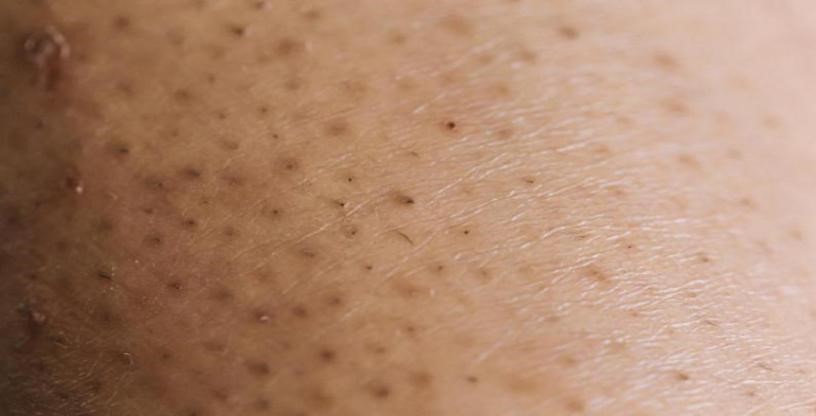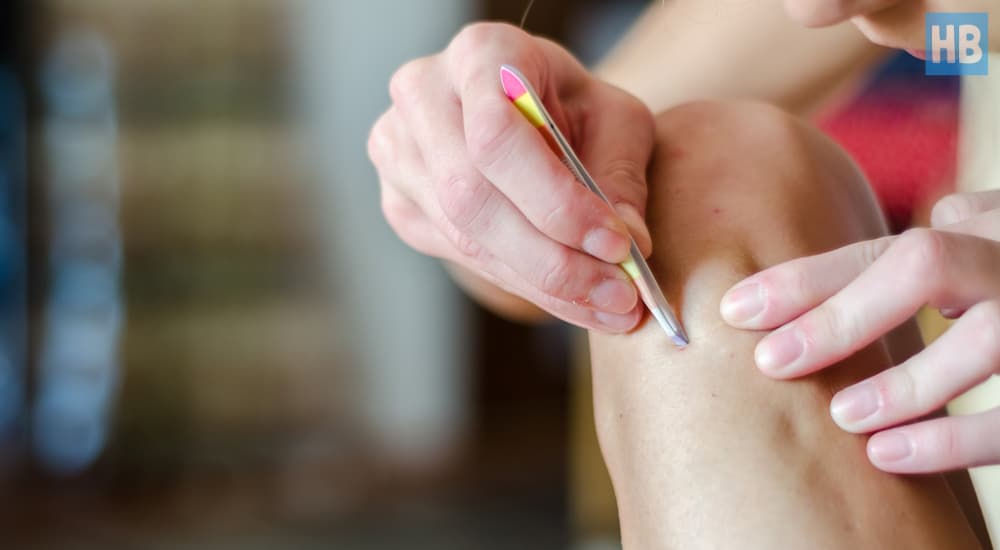Table of Contents
Women blessed (note the sarcasm) with hairy genetics understand the struggle and hard work that comes with keeping their legs hair-free and smooth. And as if that isn't enough, they also have to deal with the after-effects of their hair removal sessions, namely ingrown leg hairs.
There's no way to sugarcoat it, ingrown hairs are unpleasant, strange little bumps that our world would be better off without. Below are the things you need to know about ingrown hairs and the ways you can prevent and treat them.
What Is An Ingrown Hair?

An ingrown hair happens when a grown-out hair curls around and grows back into the skin. It is a common ramification of most hair removal methods, including waxing, shaving and tweezing. In many cases, ingrown hairs create inflamed red bumps or small dots in the areas where you had your leg hairs recently removed.
Our follicles are buried inside our skin. Normally, new hair grows upward from the hair follicles. When a hair matures, it breaks free from the skin's surface where it will continue to grow. However, there are times when the hair becomes crooked as it grows and develops under before it can exit the skin. That is when an ingrown hair occurs.
How Do Ingrown Hairs Look Like?
Ingrown hairs can irritate the skin. To a greater extent, they produce raised, reddish bumps that are often mistaken for small pimples. Sometimes if the odds aren't in your favor, they can form into painful, boil-like spots. Yep, as shuddering and scary as it sounds, but it can happen to anyone.
Often, when an ingrown hair becomes infected, it starts as a red bump. As the infection progresses, pus may form and the bump may become larger. You'll know that you have an infected grown hair if the area around is:
- Swelling
- Itchy
- Appears red and irritated
- Feels warm to touch

On the bright side of things, the most common type of ingrown hairs isn't as painful as the picture above. Personally speaking, I've had them every time I wax or epilate my legs. And yes, they don't look good at all, but at least they aren't as nasty and sore as the one shown before.

Take a look at the picture above. It's entirely different from the previous one, where the ingrown hair was clearly inflamed. In this case, however, there are no signs of inflammation. Instead, what you can see are small dark dots.
Those hairs are still ingrown hairs. However, they are still on the “early stage.” It’s like a determining phase before they either become inflamed ingrown hairs, or the hairs are naturally released from underneath and grow normally.
In my experience, I only had those tiny dots of ingrown hairs, so I don’t do much about them since they just grow out on their own.
What Causes Ingrown Hairs?
When dead skin clogs up a hair follicle, it causes the hair inside it to grow sideways under the skin.

Lots of people are used to regular shaving, waxing or tweezing various parts of their body. For women, it has become a habit to remove their leg hairs to achieve a smooth and silky pair of legs.
Unfortunately, ingrown hairs are more prevalent to women who have naturally coarse or curly hair, especially after shaving.
Why?
That is because the hair structure and the growth direction play significant roles in the development of ingrown hairs.
Curly hair tends to bend back, giving it the chance to re-enter the skin. And when you shave, you're only cutting your leg hairs off right above the skin. Moreover, shaved hairs are often cut at a certain angle that makes them sharper than normal. Therefore, even if you don't have naturally curly hairs, shaving them can cause hairs to curl back into themselves.
Once this happens, the curled hairs will start growing again at curled positions, instead of growing out of your skin as they should. Our bodies are wired to treat ingrown hairs as invaders, which is why they are often located underneath with a pimple-like or inflamed appearance.
How To Prevent Ingrown Hairs On Legs
Although ingrown hairs are far from being health risks, they can be really irritating or itchy, not to mention unsightly. Hair-free legs are great and all, but it’ll be tough to confidently flaunt your legs if they’re filled with ingrown hairs. Yeah, that sucks.
Obviously, the best way to prevent ingrown hairs is to avoid shaving, waxing and tweezing. If that's not an option, never fear because there are easy ways you can follow to prevent those oh-so pesky bumps.
Exfoliate Your Leg Regularly
Exfoliation goes a long way in preventing ingrown hairs. Mainly because exfoliating your skin extracts the excess sebum and dirt on the skin, thus, unclogging our pores. Regular exfoliation prevents your hairs from slipping back into the skin. It also loosens any hair that may be trapped beneath dead skin.
Make it a habit to exfoliate at least once a week, especially if you’re a regular shaver. Doing so will discourage dead skin cells from building up on the surface of your skin. Just so you know, dead skin can also clog your razor and cause you to have an uneven shave. Yikes!
Not sure which exfoliator to use? Try Herbivore’s Amethyst Exfoliating Body Polish. The purple body scrub has a sweet floral scent that comes from the Arabian jasmine oil. And I bet you'll be delighted to know that it contains authentic crushed amethyst.
Take a Warm Shower or Bath First
Soaking your skin with warm water will not just open up the pores, but also soften and condition your leg hairs for an easier shave. Just be careful not to use hot water. You don’t want your skin to be too dry when you shave.
Tips : Don’t soak too long because it’ll be hard to shave if your skin’s all wrinkly and swelled up.
Slather a Generous Amount of Shaving Gel.
Shaving on dry skin is a big NO !
Apply shaving gel on your skin to preserve its moisture. It makes your razor glide easily along your skin and reduces nicks and irritation. Irritated and inflamed skin can cause blockage of hair follicles, resulting in ingrown hairs.
Consider using Aveeno Active Naturals Positively Smooth Shave Gel. It moisturizes and hydrates your skin to avoid nicks and cuts. Plus, it’s gentle enough for sensitive skin types.
Shaving With The Grain is Better
When shaving, do it in the same direction as hair growth. If you shave against the direction of hair growth, it increases the chances of getting ingrown hairs and razor burns.
However, if you prefer waxing or epilating, you'll have to remove your hairs in the opposite direction to the hair growth for better results.
Moisturize Your Legs Afterward
Oh no - not so fast, ladies! I know you're in a rush to finish your shaving session and get gone. But first off, rinse your legs properly. Then make sure to moisturize your legs to lock in moisture into your skin.
Nature Republic’s Aloe Vera 92% Soothing Gel is a great option. It’s light but does its job well in moisturizing your skin. Aloe Vera is known for its soothing and anti-inflammatory properties. This makes it even more perfect for your newly shaven or waxed skin.
Ingrown Hair Treatment Tips
It's very rare for ingrown leg hairs to cause serious complications. More often than not, they either become a bit inflamed or just get resolved on their own. But if you're experiencing the former, don't fret because they can generally be treated at home.
Complications are unlikely so long as you don't leave the infection and ingrown hair untreated. In this part, we tackle some simple tips to treat your ingrown hairs :
Final Thoughts
I hear you. Ingrown hairs can be a hell to deal with, but don't let them put a damper on your life. Trust me, almost anyone who shaves, wax or epilates gets them. Knowing how to prevent and treat ingrown hairs is what matters the most.
See the video below for medical insights on how to heal ingrown hairs as advised by a dermatologist.



